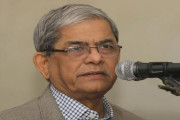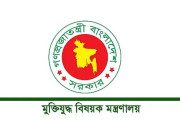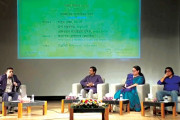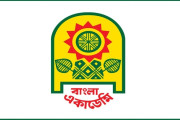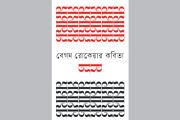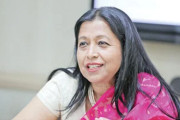।। Arun Kumar Goswami ।।
Now it is the time of ‘covid-19 pandemic’. On 12 January 2020, the World Health Organization (WHO) confirmed that a novel coronavirus was the cause of a respiratory illness in a cluster of people in Wuhan City, Hubei Province, China, which was reported to the WHO on 31 December 2019.
To check the devastating spread of coronavirus, the governments of South Asian region have imposed measures like country-wide and local lockdown alongwith closure of educational institutions in different dates of March and April. Since then, with a fear of spreading of coronavirus through close physical closeness, the authorities are not taking risk to reopen the educational institutions. However, governments are easing lockdown rules to facilitate economic activities. But there is no possibility of opening educational institutions because students are the future and the governments do not want to put them at risk. Instead, various draft-plans, proposals and measures are coming up for continuing the teaching-learning process through various modes of communication technologies. The observation, “the world will never be the same again” has been termed as the least hazardous prediction one can make about the consequence of the COVID-19 crisis. This crisis will surely change all societal institutions, not just the healthcare sector. The precise nature of that change is, at this time, unknowable. Thus the institutions of higher education need to cope with the change caused by covid-19 pandemic.
Accounts of past pandemics have become important works of literature – like Samuel Pepys’ diaries that provide a first-hand account of the 1665 outbreak of bubonic plague in London. A Journal of the Plague Year, Daniel Defoe’s 1722 novel of the 1665 outbreak, which may have been based on his own uncle’s diaries, inspired the name of the project. Accounts like these are rich in fascinating historical detail but they are limited in the voices they present.
South Asia is one of the most populous regions in the world with a total population of 1.85 billion (23.75% of the world’s total population). The region comprises of eight nation-states, Afghanistan, Bangladesh, Bhutan, India, Maldives, Nepal, Pakistan and Sri Lanka. About 74% (1.37 billion) of South Asia’s total (1.85 billion) population live in India. The region covers 3% of the world’s geographical area. South Asia has unlimited potential.
While an estimated 30 million or more are enrolled in tertiary education systems across the region, the unmet demand is estimated at three to four times this number. As South Asian countries forge a path towards growth of their industry and services sectors, the role of the higher education sector in facilitating a skilled, knowledgeable workforce has become critical – to the point of competitive advantage for many countries seeking investment.
There are two categories of closures, one is reactive and another is proactive. In an interview on March 10, 2020 Yale University’s Professor Nicholas Christakis pointed out about the number of studies that have looked at reactive closures. Some researchers have analysized data regarding the Spanish flu in 1918, where they examinined the proactive versus reactive school closures. When did [regional] authorities close the schools relative to when the epidemic was spiking? What they found was that proactive school closing saved substantial numbers of lives. St. Louis closed the schools about a day in advance of the epidemic spiking, for 143 days. Pittsburgh closed 7 days after the peak and only for 53 days. And the death rate for the epidemic in St. Louis was roughly one-third as high as in Pittsburgh. All countries except Bhutan of South Asian region followed the reactive closures. Bhutan closed its educational institutions on the same day the first case of coronavirus infection detected.
Afghanistan closed its educational institutions on March 27, Bangladesh March 16, Bhutan March 5, India March 24, Maldives April 10, Nepal March 24, Pakistan second week of March, and SriLankaclosed its educational institutions on March 16. As a consequences of these closures around 4,04,69,495 students of tertiary level in South Asia region have been affected. On the other hand, from pre-primary to upper secondary education this number is around 39,60,94,600. Totally from pre-primary to tertiary level as many as 43,65,64,095 students of South Asian countries have been affected.
Planning the measures to continue/reopen the higher educational institutions
Every educational institution, from schools, colleges to universities — both public and private stands affected by the prolonged closures and suspension of classes. It also leads to an uncertainty over finishing students’ academic years. Completing academic careers on time is critical for the future educational stages of the students of schools and colleges. In the ongoing suspension of classes, the most vulnerable to uncertainties are those at the universities. These class suspensions have been prompted by the raging Covid-19 pandemic and putting in place of measures to prevent its further spread.
It is implied that due to these lengthy closures, students are going to pass through series of disruptions in their respective academic careers. Despite the easing of lockdowns, few countries have yet to open their educational institutions. It’s because none of them want to push their future citizens into the harm’s way.
Considering the present reality, students living in remote rural areas fear to be left in the lurch compared to their urban counterparts. Of late, both the public and private universities are seen being haunted by the return of the scourge of sessions jam. The universities succeeded in uprooting the curse after a long struggle. A number of private universities, and a couple of public ones, have gone online. The public universities can, in no way, belittle the benefits of the digital service.
According to UNESCO, by March 24, over 150 countries have implemented nationwide closures apart from local shutdowns, impacting over 80 percent of world’s student population. Education authorities across the globe are scrambling to handle the unprecedented crisis, looking for immediate measures and trying to understand the longer-term implications.
On March 16, 2020 Bangladesh government decided to close all academic institutions, including primary to higher level, and dormitories until March 31, considering the growing public concern. Coaching centers across the country were also closed. Later on, it has been decided that the schools, colleges and other educational institutions will remain closed as coronavirus prevalence continue. Some 30 million students in all types of institutions and close to a million teachers and other education personnel in Bangladesh are now confined to their homes obeying the social distancing rule to fight the virus.
After unusual deferment, the results of the SSC examinations have been published on May 31, 2020. However, arranging the HSC exams for an indefinite period also come under the purview of these closure extensions and changes in the curricular schedules. Evidently, the authorities concerned have little scopes to intervene in these steps.
In the wake of the coronavirus situation, the University Grants Commission (UGC) on March 23, 2020 urged all public and private universities to continue classes online while asking them to shut down to curb the spread of the pandemic. On April 21, the commission wrote a letter to the universities seeking information on online classes. The letter asked the universities to inform it about whether online classes were in place, the number of departments that are taking the classes, and attendance rate of students.
Education Minister DipuMoni on April 30, 2020 urged all universities to continue academic activities online, including examinations and admissions, in the wake of the global coronavirus pandemic.
The education minister made the request via video conference at a meeting with the UGC and vice chancellors of public and private universities.
At this virtual meeting, the Ministry of Education and the UGC reached six decisions to ensure that universities could properly run their academic activities online, including exams and admissions.
As per the decisions of the meeting, the UGC would provide a guideline on how private universities can conduct online academic activities. At present, 63 private universities of Bangladesh are conducting their online academic activities while seven public universities have launched online classes. The UGC has also conducted a survey with a questionnaire containing more than 70 questions, among the faculty members of both public and private universities on continuance of education with the help of information communication technology (ICT). The result of this survey is yet to be known.
BHUTAN
The education ministry of Bhutan, had worked on several initiatives to engage students and continue education meaningfully.To engage students without access to television or internet, the ministry of education is now working on Self Instructional Materials (SIM), a printed version of the tele-education that has been broadcast since March 27.
INDIA
On April 29, 2020 the University Grants Commission (UGC) of India has declared the guidelines for examinations and academic calendar for the universities in view of the Covid-19 pandemic and subsequent lockdown. The commission said the exams for final semester students be conducted in July. The new academic session for freshers may begin in universities from September and for already enrolled students in August in the wake of the coronavirus COVID-19 outbreak in the country.
The UGC said that universities may chart out its own plan of action taking into consideration the issues pertaining to COVID-19 pandemic but ensure social distancing.
Universities may adopt efficient and innovative modes of examinations by reducing the time from 3 hours to 2 hours. Universities may conduct Terminal / Intermediate Semester / Year examinations in offline/online mode, as per their Ordinances/Rules and Regulations, Scheme of Examinations, observing the guidelines of social distancing and keeping in view the support system available with them and ensuring a fair opportunity to all students, it added.
MALDIVES
The Government of Maldives (GOM) declared a national health emergency on March 12, 2020 and since then several measures have been put in place to respond to the COVID-19 pandemic. These include: social distancing; restriction in air or sea travel; closure of schools, non-essential business, parks and cinemas. The most recent information available indicates that the government is slowly easing restrictions and economic activity is resuming in several places.
NEPAL
The Himalayan country of Nepal, squeezed between China to the north and India to the south, is considered by the World Health Organization to be “very vulnerable” to the coronavirus pandemic because of poor healthcare infrastructure.
Along with the tests, the university has made available at least a dozen of its constituent campuses in different parts of Nepal to be used as quarantine centres. Tribhuvan University, which is among the largest universities in the world in terms of student enrolment, has 61 constituent campuses across the country and, in addition, more than 1,000 affiliated colleges.
PAKISTAN
Government officials and education experts of Pakistan fear that educational institutions may not reopen for another six months, particularly in remote areas where safety guidelines, specially hygiene and social distancing rules, are hard to implement.
Across the country, high school students have been promoted to the next classes without taking regular examinations, and admissions to colleges will be granted on the basis of the previous year’s results.
While many universities and schools have started online classes, a majority of educational institutes in Pakistan do not have the system for distance learning. “Only a few universities have proper virtual education facilities. Others are partially equipped. Many teachers are not even trained.”
The Higher Education Commission (HEC) of Pakistan last Wednesday announced the exclusion of all newly established universities from the recurring grant scheme in the next fiscal year due to a shortage of funds, writes Rahul Basharat for The Nation.
SRI LANKA
The education ministry of SriLanka was the first to take action in order to protect the students from harm due to this pandemic situation. According to the government’s calculation educational institutions in SriLanka were closed on March 13 and by May 30, excluding holidays, students have lost 276 hours of education. To covering the lost time government has devised a plan to make up. When it comes to covering the syllabi, school hours or days will be extended. For the exams, government is considering three options one is holding the exam at regular time after covering the complete syllabus. Government assured that it will never happen, as it is insensible and inhuman step. Second option would be to postpone the exam, which has always been the popular choice for years in the past. Third will be holding the exam covering reduced syllabi.
The outbreak of COVID-19 is having a huge impact on education, higher education and recognition. The temporary closure of educational institutions due to the COVID-19 pandemic is leading to changes in qualifications, including examinations at the end of higher secondary level, which in some cases were modified by mode of delivery, postponed, or were cancelled. These changes sometimes lead to a qualification that could be based on average marks of previous learning, or no final qualification at all. This poses several issues for access to higher education, both in terms of assessment procedures and access requirements, and in terms of equality of treatment of students, fair recognition and ensuring the right to education. Recognition of disrupted learning is a crucial turning point for higher education systems and further information sharing is essential.
*The writer is Director, South Asian Study Circle, Jagannath University, Dhaka, Bangladesh.






















